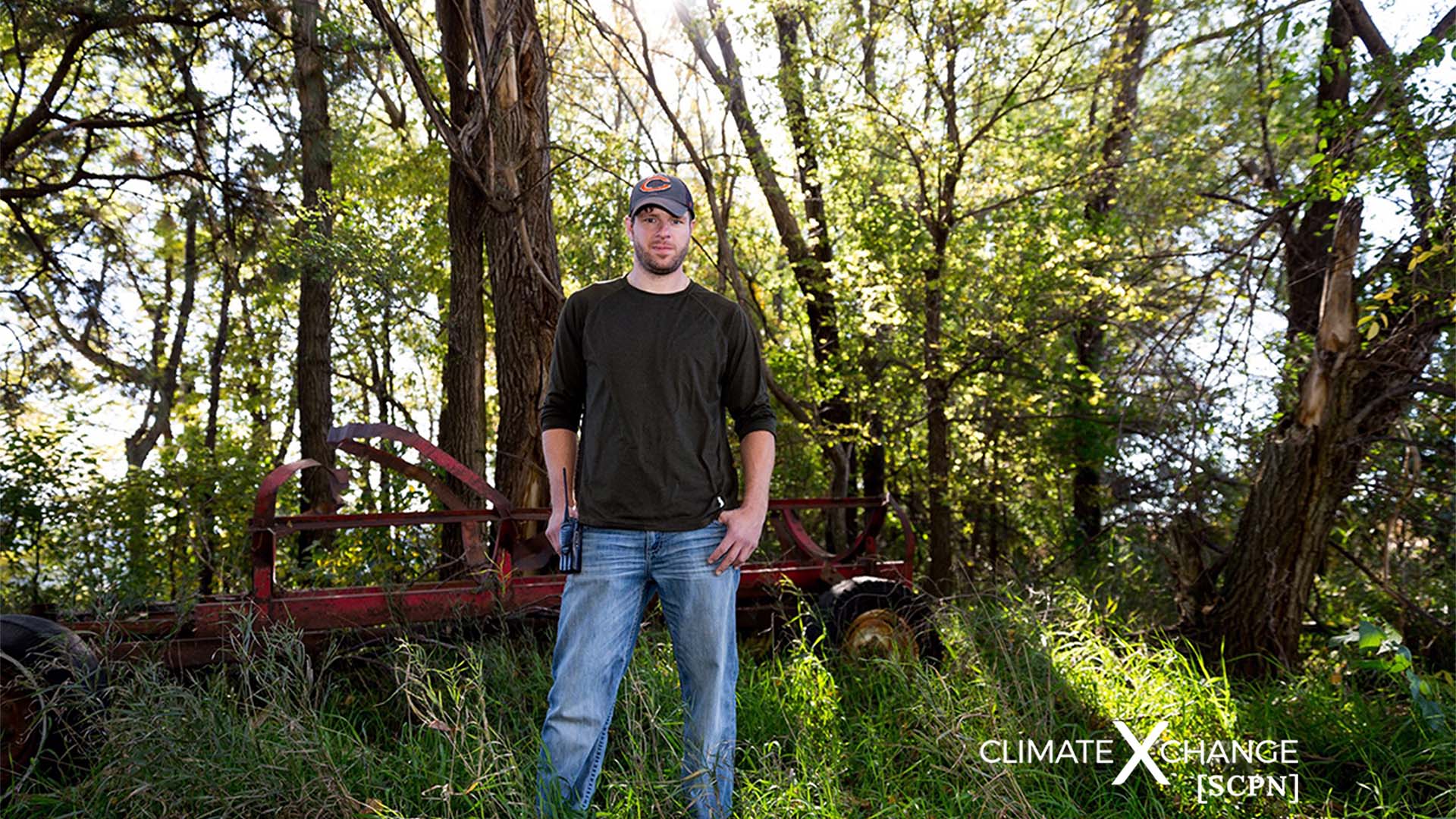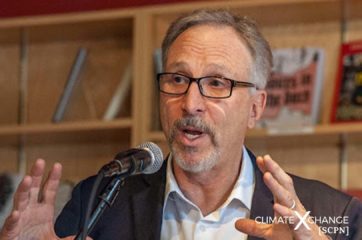All across the country, members of our State Climate Policy Network (SCPN) are fighting to make an impact on climate change in their communities. We have individuals in our Network from all 50 states, each experiencing climate change differently in their local areas and finding unique solutions to build resiliency efforts.
Graham Christensen hails from Oakland, Nebraska, and has long believed that farmers and ranchers have a critical role in reversing climate change with alternative energy and regenerative agriculture. From 2007 to 2009, Christensen helped enroll 1.1 million acres of Nebraska land into the Farmers Union Carbon Sequestration Program, which rewards farmers and ranchers for soil health practices scientifically proven to reduce greenhouse gas emissions. He has also organized with farmers and ranchers against the Keystone XL Pipeline. In 2015, he founded GC Resolve – a communication and consulting company designed to increase education and mobilization around building regenerative and resilient communities. Through an initiative called RegeNErate Nebraska, they partner with communities, farmers, and tribes to support businesses, organizations, and all that aim to advance good causes.
This interview has been lightly edited for clarity and brevity.
Holly Harpel: I want to start this conversation by asking what is most important to you right now in terms of the outcomes of your current work as it relates to agricultural climate policy?
Graham Christensen: Let me begin with some of the fundamental motivations behind the work. I have always been part of a family farm. We — my brother Max and I — are fifth-generation farmers on a farm we Homesteaded in 1867, and we’ve been farming the same land ever since. Two years ago, my dad shifted over management to my brother and I, so we’ve been implementing more regenerative, biodiverse practices. It’s been fun, interesting, and challenging, all at the same time. It’s also helped bring a lot of understanding about soil health, which is an important component of the climate conversation.
GC Resolve is a communications and consulting company. We established it in 2015 to be able to bring the level of conversation around environmentalism in Nebraska to the mainstream. I have a journalism and communications background, and I’ve done many different things in many different jobs that help bring together diverse perspectives. We want to be able to talk, Nebraskan to Nebraskan, and use our ability to be from here and a part of this culture to see through some of the propaganda and have a direct line of how our people in our state are part of the solution. We got a lot of interest in alternative energy development, too, so we formed the sister company GC Revolt, which is doing more construction and contracting.
Going back to GC Resolve, there’s a big equity piece that’s involved with this as well. There is profiteering that’s happening at the expense of our community’s and our people’s health. GC Resolve can talk clearly about these things and articulate them, and also bring in the solution because you can’t do anything unless you have the solution. We feel strongly that the solution starts with how we treat the soil and the life it produces, and that’s an Indigenous concept that goes way back. That focus turned into the RegeNErate Nebraska network.
The 3rd Edition of RegeNErate Nebraska’s Regeneration Proclamation will launch soon, and there’ll be nearly 200 network partners from different communities — such as farmers across the Midwest, inner-city communities like North Omaha and the immigration hub of South Omaha, and the reservations and Tribes from Nebraska — so that has been able to bring some connective tissue to all of the different groups. Many of them are small-budget nonprofits, a lot of farms, and businesses that support regenerative agriculture, bringing all that together so that now we can flow more smoothly on a mission focused on the soil health piece. We’re starting to see those having intended results.
We do play politically. For example, we’re now teamed up with some folks at Kiss the Ground, which allows us to organize across multiple states. Nebraska and Kansas are the first states that GC Resolve is actively helping organize a Future of the Farm tour. These are regenerative farming tours that bring the representatives out from the Agriculture Committee or Appropriations Committee to build a foundation ahead of the 2023 Farm Bill now so that our mission has time to sink in before the 2023 debate. This is so that we’re not scrambling to get basic soil health principles and water quality on the agenda at the last moment. Including these measures can help us drop carbon and cleanse the water and have a better water holding capacity so water isn’t running off into cities with lots of people, which is what’s going on now. We don’t have soil-forming capacity because we have no biodiversity, and the water quality component comes with this.
We have also co-organized a program called the Citizen Scientist Program that distributes free water testing kits for nutrients to Nebraskans who are drinking out of wells. The program has helped raise public awareness and helped us link in some of the health community – for example, the University of Nebraska Medical Center – to have a conversation around climate and health. The program just had their first convening on how to go about this. The conversation is making its way into state agencies as well, as we’re finding out who’s got that good heart, which is allowing us to be able to more constructively engage in that capacity.
Another objective at GC Resolve is to develop [local food] micro-systems. At a grassroots level, we are working to improve food systems through vacated lots in the city and starting to reconnect the farmland around the cities into schools, hospitals, and nursing homes out in the country where a majority of the population goes. Exports are fine, but we export 90 percent of our food in Nebraska, and that’s a security issue. COVID made that more clear, which also helped the momentum on this front, but the infrastructure development then goes into spending a lot more time with meatpacking workers or groups that represent them. They got stuck in COVID with no protections and with companies that are not protecting them. You can try to get laws that protect, which they tried and it didn’t work. We’ve been sitting in the back of the meetings waiting for our time to come, saying if you want to change, then you have to have more. You have to become business people yourself; you have to have ownership and know the creation of business; you have to be entrepreneurs.
If capitalism is to work, we need it to work in a way that protects. We have to be resituated into that deal because it’s not working now where people are extracting and being predatory. So, this meatpacking incident with COVID was an experience that got us to say, let’s start developing these systems in your communities and see if we can leverage these new opportunities coming around climate infrastructure or local food infrastructure. This also relates to how we look at immigrants as being future farmers. It’s this old, White industry. My culture as we know it is gone. It’s $12,500 per acre now. It’s been 150 years here with my farm and I can’t even expand, so how is any young person going to purchase land for farming? The Chinese government is investing in farmland, and so is Bill Gates, and it’s all plant-based. That’s why the farm bill is so important to invest in your young generation.
Going back to the heart of your question, the number one thing goes back to getting the land transitioned to the next generation of young, creative people that look like everyone. More young people should have a shot at farming on the land or entrepreneurial supply chain opportunities that support ethical farming practices, but we have to invest in them. All that land transitioning at a high price over the 15 to 20 years is the Baby Boomers transition. Now is a crucial time to get that land in the right hands. That is the more edgy thing we’re talking about because there isn’t good programming in the Farm Bill around that, but that is something that has to happen at this time and so that is a heavy focus now with a lot of the comments. Tonight, we’re going to talk to Congressman Bacon’s office to talk about the Maya Regeneration Project that will work to relocate these displaced agrarian people back on the land under a more biodiverse regenerative system.
Holly Harpel: I think my favorite thing about everything you’ve said is the way GC Resolve has been developed and shaped by the community partners you’re reaching, and what you’ve been able to gain from each organization. Coming from Kansas, that idea that there is no bridge between farmers and more densely-populated parts of the state resonates loudly. I think any movement that erases that line between ‘this is where the food is grown’ and ‘this is where the people live’ is so valuable.
Graham Christensen: I think that you’ve nailed that – we have all been separated, and probably on purpose. Agriculture has lost sight of the intrinsic relationships between the meatpacking industry and the supply chain workers, the farmers, and the consumers. Consumers have become the most disconnected of all. That’s not healthy, and that is where I think there can be a proper role in government.
We spent a year surveying folks before we launched anything, which is a pressure felt by all the NGOs or other people you answer to as an organizer. Having to have so many deadlines and a quota for hits on social media, but at the end of the day, were you trying to connect hearts on the ground? Were you listening to them today, and have you been a part of the conversation with all these different kinds of people? And if the answer is no, then it’s tough to think that’s going to be an effective approach because there will not have been communication or trust established. We have to be able to gain that back and establish trust where these factions were purposely segregated off from each other, which is a lifetime of work.
Let me also mention a historical connection this reminds me of. I was born in the 1980s, and the end of the ‘70s is when the Farm Crisis happened. Even into the ‘90s, a lot of family farming operations were eradicated. In the ‘80s, I woke up in the mornings as a kid literally rocking around town with tractors in the Tractor Cades with American flags, and they even went all the way to D.C. My parents were big organizers on the frontlines, tackling the big competition and concentration issues that were squeezing out the smaller family farms. Not only did their example have a big influence on me, but my parents and many other farm activists also had a big influence on the country. They had some great successes, too, because they had about 1.5 million active American Agriculture Movement (AAM) participants at the height of the movement. But now a lot of them have passed on, retired, or had to leave farming, and so we’ve continued to move towards a more vertically integrated industrialized model which looks more like indentured servitude.
In the end, after all of those amazing efforts, they got beat back, and things have continually gotten worse. What we can learn from all that is that what was missing was the connection between the farmer and the consumer. The consumers are where the numbers are, and truly, they have all the power to be able to change agriculture into an equitable, nutritious, and biodiverse system. Reaching out to more of these consumer bases or even having basic conversations about where our food comes from and what good nutrition is allows us to set up regional food systems that re-circulate the dollar locally. Future organizing efforts must unite the farmer, the supply chain worker, and the consumer.
Holly Harpel: That’s hopeful and inspiring, too. I even feel in the past ten years of my own life, there’s a successful and growing campaign around knowing where your food comes from. I wanted to ask you what’s a really exciting event that GC Resolve has been part of recently?
Graham Christensen: A recent event with the National Black Farmers Association and the Association of American Indian Farmers with John Boyd and his wife Kara Brewer-Boyd was really powerful. They came to Omaha and we were able to help get some good people to hear John’s message. I’m also really excited about these “Future of the Farm” tours that I mentioned earlier.
Furthermore, we’re folding RegeNErate Nebraska’s effort into this larger Great Plains Regeneration organization activities. Regenerate Oklahoma just formed, and they have some powerful young people that are helping to accelerate efforts in the southern plains. Big Plains Regeneration was established out of Manhattan, Kansas, so there’s synchronicity going on across the Plains in organizing through both RegeNErate Nebraska and Great Plains Regeneration. We went down to Kansas and had some meetings, one of them was on the tribal lands of the Prairie Band Potawatomi Tribe. We got to tour their hemp farm, and we fielded their questions about regeneration and regenerative agriculture.
We offered to take them up to one of our great RegeNErate Nebraska partners on the reservation land of the Winnebago in Northeast Nebraska. They’ve returned approximately 10,000 acres into Ho-Chunk Farm’s tribal farming operations, which includes agroforestry and organic and sacred Indian Corn production, as well as helping people in the community manage gardens and local food distribution systems. Those are all exciting things that have happened recently, and they’re all flowing and expanding not just in one state but breaking down those borders again and trying to build a network across the country, across the Plains, and then across the country, so it’s just more cohesive on each one of our respective areas.
Holly Harpel: That’s incredible work and a good segue into my next question. How would you describe the positive change in Nebraska, and the greater Midwest, over the past five to ten years in the shift away from extractive, industrial food production in favor of an ethical and regenerative food system?
Graham Christensen: We’ve had a series of bad events that were discouraging. The 2019 floods were pretty devastating. In this timeframe, Costco was developing chicken barns and imposing them on area residents and, according to a spokesperson at the University of Nebraska Medical Center, this poultry production operation — the largest of its kind — will forever cause problems with our area’s water supply.
Then we had the AltEn debacle near Mead, Nebraska, where neonicotinoid seed coating got into our water supply. Our state government has appeared to try to cover up the issue, leaving both human and wildlife health at continued risk.
Furthermore, farmers have been saying, ‘I wish farming was fun again,’ and that kind of mentality has just been tough for a long time, and certainly, people are feeling more pressure. Luckily farmers have seen some relief in 2021 with solid commodity markets for the first time in seven years. But this is where we are.
That’s the foundation that we have to learn from, and we’re seeing progress on that front. There’s big-time progress on the Right to Repair, which is another competition and security issue. There was a bill passed and led by Nebraska’s Republican State Senator Tom Brandt, that will open up small meat locker business opportunities and allow for more direct marketing to consumers. We also had a victory in getting a Farm to School institutional market program set up, and the city of Lincoln recently passed a Climate Action Plan that prioritizes food security.
Even more inspiring are the young people who are responding to these challenges. Regenerative agriculture yields such a positive response — unless you’re involved with the part of the industry that has been predatory and extractive. The excitement about regenerative farming is a reason I came back to the farm. I can now be more creative and utilize practices that are part of the climate solution. Regenerative farming doesn’t just mean the farmer, per se, on the land either, but it means new composting businesses, agroforestry systems, cover crop seed people, native prairie grass folks, livestock people, and even those that want to focus on fungi and mushroom production. These are just a few focuses that offer us new entrepreneurship opportunities [on the land].
Holly Harpel: It made me a little bit emotional when you said you’re hearing farmers say, ‘it’s just not fun anymore to farm’. Farming is essential to life. We’ve moved so far from ideal food systems with these monocultures and not knowing where food comes from, but I agree that we can get back to this if we keep imagining the world we want to live in and following up on that. Of course, there will continue to be obstacles along the way.
What would you say are the most pressing challenges in this transition at the local level, and what are some local strategies that you’re leading?
Graham Christensen: The greatest challenge is the aging rural areas and the lack of infrastructure out there. I think when creating more investment to transition the land to the next generation, these are undoubtedly challenges.
The other challenge is having a larger consumer base that hasn’t quite connected the dots, even though I think both you and I can acknowledge that is certainly shifting. We have to have an informed consumer base because the farmers don’t have any political power in numbers anymore. There’s money in the industry, but maintaining connectivity among us continues to be the most vital piece to overcome these challenges and continuously shift the market both through purchasing power and through good policy for consumers. [In Nebraska], we’ve noticed that we need to take a step back and do basic education. It’s a deeper understanding of the entire food production system combined with trust-building that helps us shift course.
Holly Harpel: Totally. As it’s your mission to build community spirit, as I saw on your website, who is someone you’ve met recently that you’ve learned something new from, something that can be applied to fulfilling that mission?
Graham Christensen: I’m gonna go back to the Boyds, who introduced a program that could have positive impacts for creating more collegiate education for young, diverse farmers. The program creates a scholarship for aspiring Black and Latino students at the University of Nebraska – Lincoln. Programs like this will help funnel young people into spots of regeneration across our state. For years, we’ve been developing nine to five jobs, but we haven’t been allowing enough freedom and creativity into our workspaces, and in Nebraska or the Midwest it’s even tougher.
Now what we’re doing is developing the RegeNErate Nebraska farm team. We’re trying to get more young people to have a larger role on the solution-oriented side of business, so we have also started conversations about developing an updated curriculum. I’ve written high school and college curricula around regenerative agriculture. We need to get more technical programs in the community colleges as well. It fits a need that we’ve also identified and helps develop the foundation of young people to be part of regeneration, so that we’re not backed against a corner with no environmental job opportunities, with no training, which yields no youthful energy and creativity. This is what the job climate was like in Nebraska when I first started looking for my future job after college. It wasn’t fair to me and many of my friends, and this limited ability to meet ethical goals in the workforce is not fair to the next generation.
Holly Harpel: This is a wonderful thing to hear about, and it addresses another idea on the production side, from my point of view. I see the farming and agriculture industry as something that does not seem to have entry pathways into, unless your family has had a farm or if you live in a rural community already.
I appreciate your insight into all the great programming and opportunities that are happening across Nebraska and the Midwest, and I’m grateful for the work GC Resolve is contributing to that. Thank you for your time, Graham.









